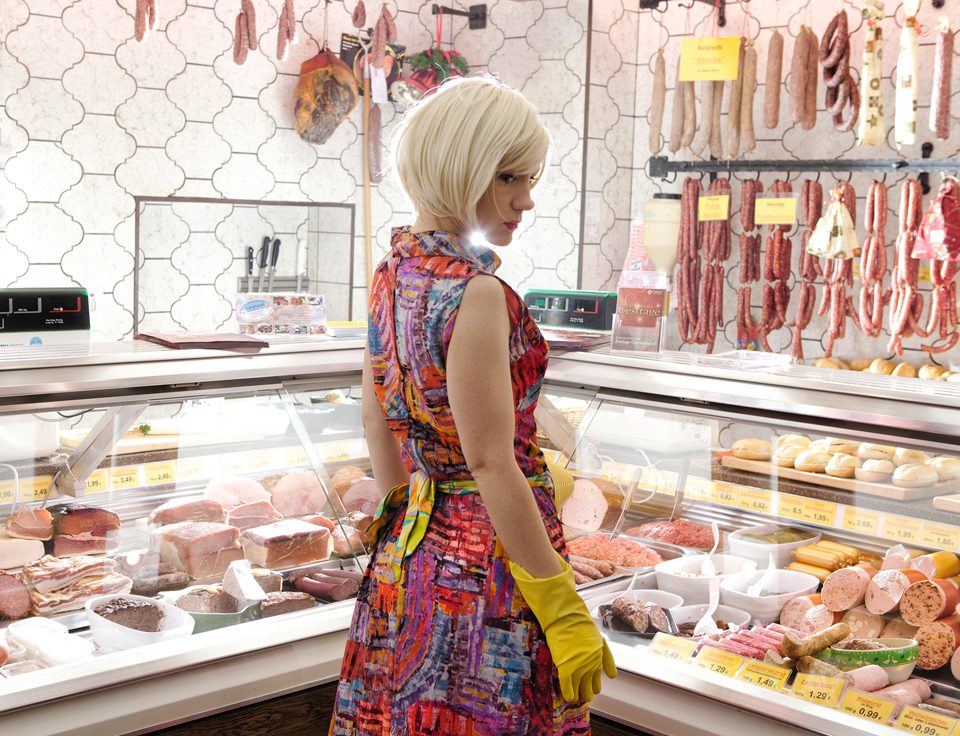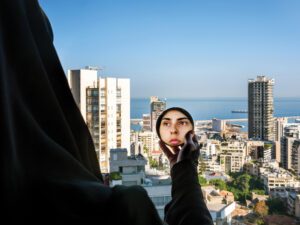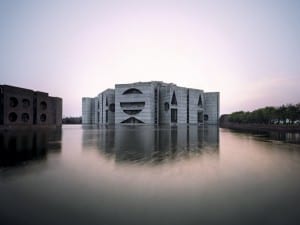An international exhibition of photography, European Chronicles in Cardiff uses lens-based media to initiate debate about European social identities.
With “Europe” and “European” both contested, fluctuating and uncertain categories, and the European ideal somewhat weathered by the economic crisis affecting most of the continent’s nations, 2013 is an appropriate and pronounced moment for an exhibition that deals with notions of European social identity. Taking place throughout May across two venues in the city, The Cardiff Story and The Norwegian Church Arts Centre, that’s exactly what European Chronicles achieves. Curated by Ffotogallery Director David Drake as part of the city-wide Diffusion: Cardiff International Festival of Photography, the show constitutes an exciting picture of photographic activity in Europe beyond the traditional art world centres such as London, Paris and Berlin.
In this, the exhibition aligns itself against what Jürgen Habermas, German philosopher and influential commentator on Europe, has called “the dangerous asymmetry where the European Union has been sustained and monopolised only by the political elites.” European Chronicles is, in part, an attempt to right that “asymmetry” by engendering a fluid and productive cultural union and exchange across Europe.
The exhibition is one project within a wider initiative regarding photography, European Prospects, which has seen Ffotogallery in Wales form partnerships with photographers and photography organisations in France, Lithuania, the Czech Republic and Germany, as well as forging strong links with individuals and organisations in Portugal, Denmark, the Netherlands, Belgium, Norway, Switzerland, Finland, Slovakia, Poland, Spain, Italy and Latvia, amongst others. The goal of the organisation is not only to celebrate a diverse range of activity across these nations but also to investigate the ways in which our identities are shaped through our visual language. At its heart, the project initiates debate and conversation across national boundaries. As Drake explains: “If you exist on the periphery (politically, economically or geographically), you will almost certainly see things differently from those at the centre – this is true at a local, national and supra-national level. European Chronicles is the start of a long-term investigation into how photographers and other artists represent a Europe ‘as lived and experienced’ rather than ‘as imagined’ by politicians or Eurocrats.”
Perhaps no artwork in the exhibition captures this exploratory and frontier spirit as precisely as Tina Carr and Annemarie Schöne’s photographic project Once We Were Birds (2009). Embodying the multi-cultural, socially engaged and collaborative ambitions of the exhibition, Carr and Schöne have consistently championed the rights of marginalised or disenfranchised communities through their longstanding collaboration. In the early 2000s, they worked closely with the residents of the Afan Valley in South Wales, dealing with high unemployment after the pit closures. However, their more recent work focuses on Roma and Traveller communities, showing their close family ties, culture, skills and musicianship. They are particularly concerned about the wave of police violence and persecution shown towards Roma communities in Europe, and protecting their right to a peaceful nomadic existence.
Once We Were Birds focuses on Roma communities to the North East of Budapest in Hungary, where unemployment is 100%. What is perhaps most striking about the work of Carr and Schöne is the positivity of the images themselves. Roma people are shown nurturing children and animals, practising their Roman Catholic faith and engaging in agricultural tasks. The images are defiantly and quietly affirming. The photographers describe their intent in the following terms: “We make positive images that challenge the stereotypical view and try to break down prejudice and negative attitudes towards this very misunderstood people.”
One of the great curatorial strengths of European Chronicles is the variety of works included in the exhibition, presenting challenging interpretations and engagements with notions of European (and other forms of) identity. The practice of German artist Catrine Val stands out in this regard. Her work is distinctive within the exhibition due to its less obvious link to a “documentary” tradition, exploring instead aspects of performance. However, as Drake points out: “The term ‘documentary’ itself is more ambiguous nowadays as there are documentary photographers who have a conceptual approach, and conceptual artists who incorporate the language of documentary photography in their practice. Yes, Catrine’s work is strongly performative, but there are performative elements to other projects we have included such as Anna Kurpaska’s The Visit, Mindaugas Ažušilis’ Happiness in Lithuania and David Barnes’ King Tide.”
Val’s contribution to European Chronicles is Feminist, a photographic series in which the artist transforms herself into convincingly constructed characters through an arsenal of exhilarating and quickly manufactured disguises, making use of props, clothing, hairstyle, posture, demeanour and other social and cultural markers. Val has spoken of the experience of taking the dual roles of photographer and model in her work; the demands she would place on herself in terms of diet to ensure she fitted into the tailored clothing for the shoot. In this way, she has undergone the high-pressured and demanding procedures that fashion models go through permanently. In its dramatic rendering of performativity and identity politics, Feminist not only enacts a cultural critique of the pressures to conform, but also investigates the ways that homogenisation, commodity fetishism and over-consumption have impacted upon the ways we identify ourselves. For example, in one image, Val is cast as a middle-class shopper in the dazzling cleanliness of a butcher/delicatessen, surrounded by strings of sausages, hunks of ham and sharpened knives.
The performative elements that Drake observes in Welsh photographer David Barnes’ work are expressed in the durational aspects of his seven-year project and in the multimedia approach taken to the work, which fuses installation with video and photography. King Tide focuses on one particular working class family in a South Wales Valley community, and documents their lives. The ongoing nature of the project is vital to its success, opening up inconclusive vignettes in a kind of anti-soap opera aesthetic. While the family is in its third generation of unemployment, and struggling financially, King Tide portrays their daily life and relationships with each other with positivity, understanding, empathy and grace rather than judgement and negativity.
While the family at the heart of the work is one subject for the series, another is the passing of time itself. In one image, three generations of male members of the family are aligned haphazardly in a line, with the youngest and the oldest each engrossed by their own, separate mobile phones. The third is pinching tobacco from a packet. While this image is familial and warm, there is a darker side to the inescapability of the family’s situation. The youngest, who is a teenager, is wearing a hoodie with the word “Everlast” on the front. While the hoodie might be unzipped and the word broken up and difficult to make out, it is difficult to see how the boy could in fact break out of a generations-old cycle of poverty and unemployment. Drake comments: “There is a great deal of warmth, empathy and humour in the work – but also a certain strangeness (for example, the nocturnal fishing expeditions and motorbike rides). The level of trust that was built up between the artist and the family was such that they contributed creatively to the project in the form of video material and hand-made artefacts.”
Norwegian artist Elin Høyland, whose work is shown in the Norwegian Church Arts Centre, is represented by her photographic seriesThe Brothers (2011), which also deals with the passing of time and the minutiae of existence. The series is a highly poetic and intimate portrayal of the relationship between two brothers who lived together on a smallholding in remote rural Norway. Recording the rhythms and routines of a way of life that has all but disappeared, her work is moving in that there is a palpable sense of fragility and temporality related to the brothers’ uncomfortable situation vis-à-vis the contemporary world.
Investigating isolation and solitude in equal measure as trust and companionship, The Brothers is about blood relationships, place and identity. It has a curious and compelling magic, as it also depicts a lifestyle that many Europeans secretly desire as an alternative to the bustle of the modern world. In one image, the clash between contemporary and traditional value systems is laid bare: emblazoned on one brother’s mug is the slogan “I HEART COFFEE” while the other brother’s mug contains a traditional woodland flora and fauna design. Both emblems are perhaps equally hollow and vacant, and yet they seem to point to a central dichotomy between conflicting ways of life.
However, if Høyland tempts us to rediscover a fast sinking way of life, the work of young Lithuanian artist Mindaugas Ažušilis rails against apathy in all its forms and provokes the viewer to engage with the modern world. His theatrically poised and ironic images are wittily titled Happiness in Lithuania, and they set target on the banal, the conceited and the comfortable. In one image, a man is seen urinating against a tree, with his black car parked angular to his body as if in a showroom; in another, a crowd of school children swarm around a kebab vendor at his hut. However, perhaps the mood of Ažušilis’s work can be best understood from an image in which a group of teenage boys in swim gear sit in an empty hot tub as it is towed behind a truck laden with felled logs. Printed across the hot tub is the word “Baseinas”, Lithuanian for “Swimming Pool.” Conveying humour and horror in equal measure, the youthful swagger of the boys is tempered by their counterpoint: the logs. They are literally being taken for a ride: hook, line and sinker.
While Ažušilis’ images have a composure and wit that steers clear of anger, they faultlessly convey a sense of deep impatience with the contentment with material “happiness” or the appearance of “happiness.” Ažušilis’ irony is especially biting when it comes to masculinity. For example, an overprotective (if underdressed) man stands in his underwear wielding a gun above his head, guarding a portacabin with two blacked out windows that may or may not be his home. What is particularly unsettling about this image is the creeping sense of intolerance and confidence. The gun, along with the boxer shorts, is a show of strength rather than a response to a real threat. When considered as a series, this man is a haunting future ghost of the jovial youths in the swimming pool.
Ažušilis’ contribution to European Chronicles is a testament to the project itself, presenting work by a major emerging talent from a smaller European nation who is profoundly and importantly engaged in investigating social identity, both nationally and within Europe. As such, his work is ideologically aligned with the curatorial concept of the exhibition. As Drake says: “European Chronicles, and perhaps Diffusion as a whole, addresses and challenges the tendency for smaller member states to feel politically and economically overshadowed by larger and more powerful players in Europe. It explores how photographic artists in small nation states and second cities gain strength, confidence and visibility through artistic and cultural exchange – and to use a photographic analogy borrowed from August Sander, can ‘come out from the shadows into the light’. The curatorial premise is to foreground artistic work that is locally rooted, but externally engaged with wider European themes and influenced by international currents in contemporary art.”
European Chronicles is just one component of the wider Diffusion: Cardiff International Festival of Photography. With exhibitions and events taking place across the city, the festival features artists from across the globe, including Korea, South Africa, Portugal and Canada. However, another critical aspect of the festival is its role in providing a platform for both established and emergent Welsh artists. Above all, Diffusion is a celebration of the power of the photographic image to reflect society and provoke a reaction.
European Chronicles runs from 1 May – 31 May at The Cardiff Story and from 1 May until 25 May at The Norwegian Church Arts Centre as part of Diffusion: Cardiff International Festival of Photography. www.diffusionfestival.org.
Colin Herd





